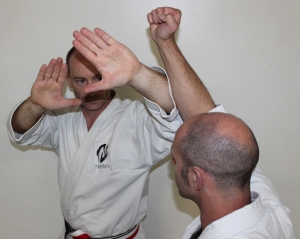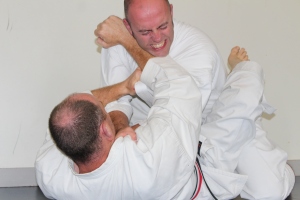It is the most instinctive of gestures made when a threat to the face is perceived; raising the hand (either right or left, or both together) to protect the face and prevent injury. It allows us to hide behind the safety of the perimeter that our arms create, absorbing the impact, assessing the level of threat and getting ready to act. This raising of the arms is readily visible in the kata Yara Kusanku (Kanku-dai). It is stylised in many different ways and translated as “look to the sky”.  However, this just means to raise your hands and the stopping point is elevated in front of the head. In a practical context, this represents the forming of a defensive perimeter at any level depending on the angle of attack as shown in the picture.
However, this just means to raise your hands and the stopping point is elevated in front of the head. In a practical context, this represents the forming of a defensive perimeter at any level depending on the angle of attack as shown in the picture.
Raising a single arm to defend the head is best recognised as an age-uke (揚受) or rising block. It is among the first moves that a beginner level student will learn when they start mainstream karate. Using the raised forearm as a block, a strike, a lever or a choke/strangulation will depend on the proximity of the two parties during the encounter. Distance will be a determining factor in the purpose for the rising block.
One of the most common and recurring attacks is the grab or push with the left hand followed by a strike with the right hand. This includes both vertical and horizontal trajectories which will come towards the top of the head or the left side of the face. Considering that we live in a predominantly right handed society, this is one of the most common assaults on the person.
In this context we teach beginners to block the attack as it travels in a vertical arc towards the head. Commonly referred to as an “ice pick attack”, and satirised by Jim Carey (Youtube: Jim Carey’s Karate School of Self Defence) to great effect, the age-uke in this case is used to block or receive the attack with the intention of delivering a sharp counter. The counter used will once again depend on the ma-ai (間合) or combative engagement distance. At arms-length, a straight punch might suffice while closer in, an uppercut to the opponents jaw would be more in order.
Very often, two protagonists will engage in a standing clinch. This will not necessarily be by mutual consent and could even result after the attacker grabs using an over arm bear hug in an attempt to gain control. Breaking the attention of the attacker is one of the key elements to a successful counter. In this case, using the right hand to grab the testicles (presuming it is a male antagonist) will ensure that you know where the attacker’s hands will go. The pre-determined response to this action will be for the attacker to grab your hand and try to take it off their testicles. Once they have grabbed, the cross-extensor reflex will be to not let go of your hand. Taking a sharp step back and dragging the attacker with you will jerk them forward, turn/move their head, and momentarily expose their neck. Executing an age-uke at this point will impact them on the carotid junction (side of the neck) as shown in the picture.  The net result is a temporary and non-lethal disruption of blood supply to the brain which in turn causes a brief weakness in the opponent allowing for an appropriate follow up to disengage.
The net result is a temporary and non-lethal disruption of blood supply to the brain which in turn causes a brief weakness in the opponent allowing for an appropriate follow up to disengage.
Finally, in a close range grapple for control, the age-uke can be used very effectively as a choke/strangulation to gain the upper hand. In many instances, this will happen on the ground and form part of the strategy of regaining a standing position. Positioning one hand across the throat with a thumbs down grip on the lapel, the other hand will grab the opposite lapel in a regular grip as shown in the picture. Executing the age-uke in this scenario will pull the left hand further into the throat of the attacker and cause severe discomfort at the very least as the pressure mounts.
As a block, a strike or a lever, the age-uke is a versatile tool in the arsenal of any karate-ke. It is a technique that deserves exploration in training to fully understand its potential in a self-defence context. Working with a partner, using two person flow drills, in a controlled training environment is the best way to experiment and learn how to use this technique. Remember, in self-defence training, it makes sense to have a complete toolbox and never need all of the gear rather than consider the alternative!
Damien Costello is a Renshi level instructor in Koryu Uchinadi and one of Hanshi Patrick McCarthy’s shibucho in Ireland. For further details on upcoming events or enquiries about incorporating Koryu Uchinadi concepts into your training please contact info@ku-ireland.com and check www.ku-ireland.com for regular updates.